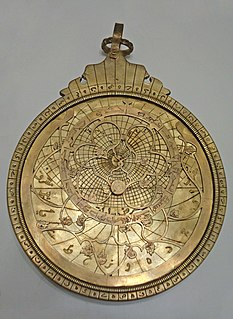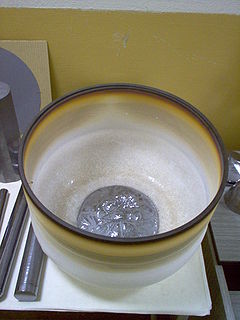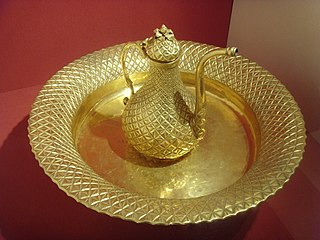
Brass is an alloy of copper and zinc, in proportions which can be varied to achieve varying mechanical and electrical properties. It is a substitutional alloy: atoms of the two constituents may replace each other within the same crystal structure.

Bronze is an alloy consisting primarily of copper, commonly with about 12–12.5% tin and often with the addition of other metals and sometimes non-metals or metalloids such as arsenic, phosphorus or silicon. These additions produce a range of alloys that may be harder than copper alone, or have other useful properties, such as stiffness, ductility, or machinability.

Metallurgy is a domain of materials science and engineering that studies the physical and chemical behavior of metallic elements, their inter-metallic compounds, and their mixtures, which are called alloys. Metallurgy encompasses both the science and the technology of metals. That is, the way in which science is applied to the production of metals, and the engineering of metal components used in products for both consumers and manufacturers. Metallurgy is distinct from the craft of metalworking. Metalworking relies on metallurgy in a similar manner to how medicine relies on medical science for technical advancement. A specialist practitioner of metallurgy is known as a Metallurgist.

Zinc is a chemical element with the symbol Zn and atomic number 30. Zinc is a slightly brittle metal at room temperature and has a blue-silvery appearance when oxidation is removed. It is the first element in group 12 of the periodic table. In some respects, zinc is chemically similar to magnesium: both elements exhibit only one normal oxidation state (+2), and the Zn2+ and Mg2+ ions are of similar size. Zinc is the 24th most abundant element in Earth's crust and has five stable isotopes. The most common zinc ore is sphalerite (zinc blende), a zinc sulfide mineral. The largest workable lodes are in Australia, Asia, and the United States. Zinc is refined by froth flotation of the ore, roasting, and final extraction using electricity (electrowinning).

Calamine is a historic name for an ore of zinc. The name calamine was derived from lapis calaminaris, a Latin corruption of Greek cadmia (καδμία), the old name for zinc ores in general. The name of the Belgian town of Kelmis, La Calamine in French, which was home to a zinc mine, comes from this. In the 18th and 19th centuries large ore mines could be found near the German village of Breinigerberg.

A crucible is a ceramic or metal container in which metals or other substances may be melted or subjected to very high temperatures. While crucibles historically were usually made from clay, they can be made from any material that withstands temperatures high enough to melt or otherwise alter its contents.
Cymbals are made from four main alloys, all of them copper-based. These are: bell bronze, malleable bronze, brass, and nickel silver.

Metalworking is the process of working with metals to create individual parts, assemblies, or large-scale structures. The term covers a wide range of work from large ships and bridges to precise engine parts and delicate jewelry. It therefore includes a correspondingly wide range of skills, processes, and tools.

Nickel silver, Maillechort, German silver, Argentan, new silver, nickel brass, albata, alpacca, is a copper alloy with nickel and often zinc. The usual formulation is 60% copper, 20% nickel and 20% zinc. Nickel silver is named due to its silvery appearance, but it contains no elemental silver unless plated. The name "German silver" refers to its development by 19th-century German metalworkers from the Chinese alloy known as paktong or baitong (白銅). All modern, commercially important nickel silvers contain significant amounts of zinc, and are sometimes considered a subset of brass.

Bronze is the most popular metal for cast metal sculptures; a cast bronze sculpture is often called simply a "bronze". It can be used for statues, singly or in groups, reliefs, and small statuettes and figurines, as well as bronze elements to be fitted to other objects such as furniture. It is often gilded to give gilt-bronze or ormolu.

Repoussé[ʁəpuse](listen) or repoussage[ʁəpusaʒ](listen) refer to a metalworking technique in which a malleable metal is shaped by hammering from the reverse side to create a design in low relief. Chasing, chased work, or embossing refer to a similar technique, in which the piece is hammered on the front side, sinking the metal. The two techniques are often used in conjunction.

A coppersmith, also known as a brazier, is a person who makes artifacts from copper and brass. Brass is an alloy of copper and zinc. The term "redsmith" is used for a tinsmith that uses tinsmithing tools and techniques to make copper items.

Tombac, as it is spelled in French, or tombak, is a brass alloy with high copper content and 5–20% zinc content. Tin, lead or arsenic may be added for colouration. It is a cheap malleable alloy mainly used for medals, ornament, decoration and some munitions. In older use, the term may apply to brass alloy with a zinc content as high as 28–35%.

Gun metal, also known as red brass in the United States, is a type of bronze – an alloy of copper, tin, and zinc. Proportions vary but 88% copper, 8–10% tin, and 2–4% zinc is an approximation. Originally used chiefly for making guns, it has largely been replaced by steel. Gunmetal, which casts and machines well and is resistant to corrosion from steam and salt water, is used to make steam and hydraulic castings, valves, gears, statues, and various small objects, such as buttons. It has a tensile strength of 221 to 310 MPa, a specific gravity of 8.7, a Brinell hardness of 65 to 74, and a melting point of around 1,000 degrees Celsius.
Calamine brass is brass produced by a particular alloying technique using the zinc ore calamine directly, rather than first refining it to metallic zinc. Direct zinc smelting appears to have been unknown in Europe until the mid-18th century, even though the alloyed calamine brass was in use for centuries, and metallic zinc was produced directly via reducing-atmosphere smelting in India and China from the 12th century CE onwards.

Spelter is a zinc–lead alloy that ages to resemble bronze, but is softer and has a lower melting point. The name can also refer to a copper–zinc alloy used for brazing, or to pure zinc.

Metals used for architectural purposes include lead, for water pipes, roofing, and windows; tin, formed into tinplate; zinc, copper and aluminium, in a range of applications including roofing and decoration; and iron, which has structural and other uses in the form of cast iron or wrought iron, or made into steel. Metal alloys used in building include bronze ; brass ; monel metal and nickel silver, mainly consisting of nickel and copper; and stainless steel, with important components of nickel and chromium.

The use of bronze dates from remote antiquity. This important metal is an alloy composed of copper and tin, in proportion which vary slightly, but may be normally considered as nine parts of copper to one of tin. Other ingredients which are occasionally found are more or less accidental. The result is a metal of a rich golden brown colour, capable of being worked by casting — a process little applicable to its component parts, but peculiarly successful with bronze, the density and hardness of the metal allowing it to take any impression of a mould, however delicate. It is thus possible to create ornamental work of various kinds.















